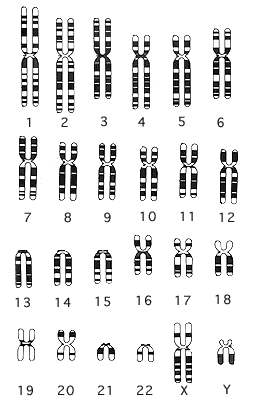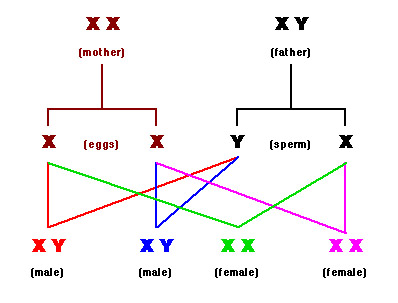by Diane Mason
VIEW LAB RESULTS FOR OUR MEMBERS
Most of you have heard of the many advances being made in the study of genetics. DNA testing is being used to prove paternity and to screen for genetic diseases. Scientists have also discovered that DNA testing can be used in the study of genealogy. To see how this works we'll need to take a little trip back to high school Biology class:
All humans have 46 chromosomes. All of our DNA is contained in these chromosomes. Forty-four of our chromosomes are formed by a process known as recombination. The genetic information on these chromosomes is a result of the combination of DNA from both parents. In turn the information donated by each parent is the result of a combination of DNA from their parents. These chromosomes contain bits and pieces of DNA from many people in your family tree. The other two chromosomes are called the sex chromosomes. They are called the X chromosome and the Y chromosome because they look like the letters X and Y under a microscope. These chromosomes have one main function: to make a child either a boy or a girl. Women have two X chromosomes and men have an X and a Y. One of the chromosomes has been passed to you in complete form from one of your parents and the other chromosome comes to you in complete form from the other parent. There is no intermixing of DNA in these chromosomes.
 |
 |
Since only men have the Y chromosome and they only have one of them, there is only one possible path of inheritance for the DNA on this chromosome. All men inherit the DNA on their Y chromosome in largely unaltered form from their father who inherited his Y-DNA from his father in largely unaltered form, etc. This means that all direct male line descendants of a particular male ancestor will have DNA on their Y chromosomes that are identical or very nearly identical.
There are now companies that have been formed specifically to assist family history buffs to make connections with others through the testing of DNA. These companies test short segments (called markers) of the Y chromosome. Each of these segments has been given a scientific name to identify its particular location on the DNA strand. You'll see names such as DYS 390 and DYS 439. In the testing process the markers are given numerical values that are called alleles or repeats. Repeats is an easier way to understand the values. Each of the markers has its own unique sequence of chemicals. This sequence is repeated over and over again within the marker segment. The numerical value equates to the number of times the sequence is repeated. If DYS 390 has a value of 10, then the unique sequence of chemicals that defines DYS 390 was repeated 10 times (repeats, alleles). You've also heard of DNA mutations. The actual chemical sequence in a marker will never change, but the number of times it repeats will, hence a repeat change would increase or decrease the number value and would be called a mutation.
We can use Y chromosome DNA testing by comparing the number of repeat values for several markers between two or more people. The repeat value is passed from generation to generation in largely unaltered form. There will be an occasional mutation but the majority of marker repeat values will be the same for two people with a common ancestor.
Now that you know everything there is to know about DNA testing you probably want some specifics on the Mason DNA Project. Our goal is simple: To find biological connections between as many Mason branches as possible.
We have chosen to use a company called Family Tree DNA. This company was founded exclusively to provide DNA testing for the genealogist. Other companies started out in health related or paternity testing and took on genealogy as an afterthought. Not so with Family Tree DNA.
To participate (1) A Mason male with an unbroken male to male lineage of a Mason ancestor must provide a order a Ydna test kit and dna sample material (mouth wash or cheek swab), and (2) must submit a "mini family tree" leading back to the oldest known Mason ancestor.
Use the "join project" link in the left menu.
Understanding Your Results: Are We Related?
Due to the desire to find those to whom we are related, it is easy to look at Y DNA test results and interpret that the people are related, when the degree of relatedness is most likely outside the time frame of genealogy. Surnames are a key element in establishing a genealogy time frame for evaluating results. All of us are related at one point in time, though this is not relevant to our genealogy time frame.
The Y DNA test is an excellent tool to determine those whom are "not" related within a group of people that share the same or similar surname. When 12 Marker Y DNA test results indicate that two people are related, it is important to consider the time frame indicated by the results. The common ancestor for two participants is known as the Most Recent Common Ancestor, or MRCA. The time frame to the MRCA is shown as a range of time, with probabilities. Y DNA testing does not identify the common ancestor, or specify an exact time frame. Instead, the time frame is a range of generations, with a probability of whether the common ancestor occurred within the range. For a 12/12 match, the range of generations for when the common ancestor occurred, is 1 to 62+ generations at a 95% confidence level. An exact end to the range can not be scientifically identified. Having a common surname establishes the end of the range as the time the surname was adopted.
Using a figure of 25 years per generation, the range for the time frame of the MRCA is 25 to 1550 years. Having a common surname reduces that range. Surnames evolved at different times in different countries. If, for example, surnames evolved in your ancestral country in the 1400's, then the range for the time frame of the MRCA would be 25 to 600 years.
The next step to interpreting your results is to look at the probabilities associated with the time frame of the MRCA. Scientists calculated these probabilities, and divided the range of generations into 3 parts, or subsets. These 3 subsets are the generations to the MRCA at a 50% probability, a 90% probability, and a 95% probability. For those who are not familiar with probability, a 50% probability means that half the time the common ancestor would occur before the number of generations specified, and half the time the common ancestor would occur after the number of generations specified. For the 90 and 95% columns in the chart below, these columns mean that 90, or 95%, of the time, the common ancestor occurred within the specified generations.
For a 12/12 match, the chart below shows the number of generations for the common ancestor, and the probability:
Probability: 50% 90% 95%
Generations: 14.5 48 62
As shown in the chart above, a 12/12 match indicates that 90% of the time, the common ancestor occurred within 48 generations. 95% of the time, the common ancestor occurred within 62 generations. 62 generations, using an average of 25 years per generation, is 1550 years. Most likely, surnames were adopted more recently than 1550 years, perhaps 600 years ago. Therefore, the common ancestor occurred since the adoption of surnames, assuming both participants have the same or variant surnames. If the common ancestor has been identified by family history research, and there is an adequate paper trail, these probabilities aren't significant. The common ancestor has been identified, and the purpose of the Y DNA testing is to confirm the research. If a common ancestor for participants has not been identified, then the probabilities are important. The chart above covered the probabilities for a 12/12 Match. The chart below covers the probabilities for a 25/25 match: Probability 50% 90% 95%
Generations 7 23 30.4 As you will notice, the time frames to the common ancestor are significantly shorter for each of the probabilities when a 25 Marker Y DNA test is used. The time frames have roughly been cut in half with a 25 Marker Y DNA test.
When interpreting results from a 12 Marker Y DNA test, one factor to consider is whether the common ancestor has been identified with a paper trail. If there is a paper trail from both participants to the common ancestor, you have identified the common ancestor. The 12 Marker test may be sufficient, in this case, to confirm the family history research.
A word of caution is necessary. The words "documented research" have many interpretations. The participants may have made up their family tree off the Internet, and call it documented. Even precise dates and locations, which infer some level of research, can be misleading. The author of this article was recently reviewing a pedigree submitted by a participant. The "documented" family tree went to the 1700's, with precise locations and dates for births, marriages, and deaths. The author validated the research for the period 1855 to present. The family had immigrated to the US in 1855. Validating the research in the ancestral country required reviewing the parish registers. After reviewing the Parish Registers for the relevant location for the time period of 1773 to 1855, and all the surrounding parishes, not a single event was found!!! There were serious flaws in the research. It may not be possible for Group Administrators to validate a participant's research, due to time considerations. At the minimum, it is recommended that a random sampling of events are validated. Where the common ancestor is identified, and you are considering that this participant's tree represents a branch of your family tree, you most likely would want to validate all the research for their tree.
This chart shows the probabilities and generations:
24/25 Match 18 41 52
Probability 50% 90% 95%
--------Generations--------
12/12 Match 14.5 48 62
11/12 Match 36.5 84.7 103.4
25/25 Match 7 23 30.4